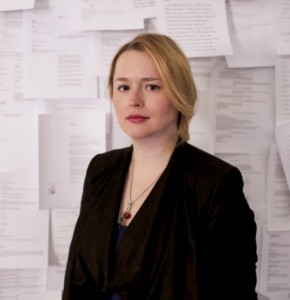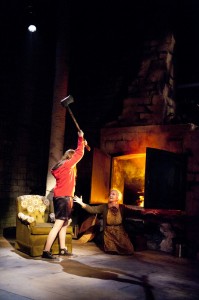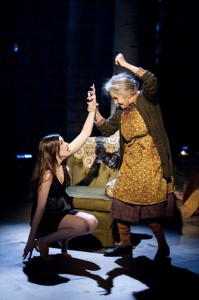By Jonathan Williams
Once upon a time. It’s the way many fairy tales begin, so it’s only fitting that the Russian equivalent of that phrase is used to begin The Fairytale Lives of Russian Girls, the 2012 winner of the Alliance/Kendeda Graduate Playwriting Competition. The world premiere of the play (on the Alliance Theatre‘s Hertz Stage through Feb. 26) draws strong parallels between the events of Russian folk tales and the events of the lives of contemporary Russian girls, to the point that it becomes difficult to distinguish between metaphorical fantasy and literal reality. Even though these stories are uniquely Russian, American audiences are likely to recognize elements from stories such as Little Red Riding Hood, The Three Bears and Hansel and Gretel. But what might be more difficult to grasp is just how similar contemporary Russian life can be to the folk tales embedded into its culture. But, as Nastya (played by Bree Dawn Shannon) reiterates, “This shit happens.” Playwright Meg Miroshnik conceived of The Fairytale Lives of Russian Girls after visiting Russia a few years ago. As the play’s first run winds down, she talks to Wrestling with Pop Culture about the show’s fairy tale influences and going to see Empire/Platinum Championship Wrestling with one of the stars of her play while she was in Atlanta.
I’ve seen Diany Rodriguez, who plays Masha, several times at the Academy Theatre. But not in any of the plays there.
PCW! Yeah, she took me along. It was actually one of my favorite things I did while I was in Atlanta.
Oh, so you went with her. How many of those shows did you go to?
I just went one Friday. It was really great.
I got used to seeing her there every Friday night, but I had no idea she was an actress. So when I saw her come out at the beginning of The Fairytale Lives of Russian Girls, I realized why I hadn’t seen her at the wrestling shows in a few weeks.
It was really fun to see her at those shows because she’s such a small person, but she’s just so careless with her aggression when she’s taunting the wrestlers. It was kind of great for her character [whose abusive boyfriend becomes a bear], actually, to see her like that. Even knowing how theatrical the event was, at a couple of points I got a little scared for her because she was so aggressive with these big guys.
Your play is obviously a little bit different from wrestling, though it does blur the lines between fantasy and reality in some similar ways. A lot of the fairy tales referenced in your play are familiar to American audiences. Do children in Russia grow up reading pretty much the same stories?
I think a lot of them are sort of cousins of fairy tales that Americans grew up with. The Russian fairy tales in this show are Masha and the Bear, which is the story Diany tells (of course it’s modified to exist both in a contemporary Moscow and an older Russian folk tale world.); The Wise Little Girl, the riddle story Katya tells, is a fairy tale; Baba Yaga is true to the fairy tale; and the story that Nastya tells of the fearful bride is (aside from the retribution of the ending, which I added) is almost word-for-word the Russian fairy tale.
A lot of them are very familiar to American audiences, but the things I was interested in were sort of different. Baba Yaga was the first character that really inspired me to write the play and I was really interested in the idea of a witch. She feels kind of like Hansel and Gretel‘s in a lot of stories, especially stories where little girls are forced to stay with her. But she’s also a secondary or tertiary character in a lot of other stories that focus on male heroes, where she’s just this background character that is very helpful and grandmotherly. So I was interested in that dichotomy. I felt like it was very different than the fairy tales I had grown up with where the witches were just bad. I thought she was a little more complicated.
There are certain phrases that are repeated, particularly one where older women tell younger women they can smell their bones. Phrases like that sound a little odd to an American audience, but are those common phrases in Russia?
The idea of a girl having the smell of the roots about her actually does come from Russian folk tales. My hopes with reusing some of those phrases was that they then take on very different meanings. Like when Valentina is telling Katya she smells her bones and that disgusting body spray, it kind of exists in both the fairy tale and the real world in that way. Hopefully those phrases become a little more familiar as they’re repeated throughout the play.
Considering that you are weaving fairy tales into reality, how literally is the audience supposed to take some of these stories? Since it’s pointed out a few times that the American protagonist Annie speaks Russian with an accent, is that meant to imply that maybe she is taking metaphorical things literally because she’s not as fluent in the language?
It’s interesting to talk to audience members afterward and see how literally people take it, especially the ending. It’s been pretty split. The balance I’ve always described is it’s 20 percent fairy tale and 80 percent real world in the beginning of the play and that ratio is very quickly inverted so that by the end we’re living in an 80 percent literal fairy tale. I wanted the situations to be able to exist in both contexts, so after they kill Valentina and Baba Yaga you get that line of “two suicides in one night,” drawing a parallel for the audience of what this would be if it were just a metaphor. Of course there are some design elements that point us towards more literal interpretations like, obviously, having a bear on stage tips the balance there. But I wanted both to exist throughout the play.
I also noticed a lot of reference to eyes, such as the evil eye pendant Annie’s mother puts on her coat before sending her to Russia and Baba Yaga’s line about the potatoes having eyes when Annie is trying to run away. It reminded me a little of Edgar Allan Poe, but is that a common theme in Russian folk tales?
There’s a sense of superstition that pervades the whole play and the evil eye was an important part of that for me. Since it starts out as a fairy tale does, with the heroine setting out on a journey and receiving a warning, I thought that was an important way to do that. And that type of superstition in the culture is definitely real. There are very specific things you don’t do because of bad luck. The way Olga buys into the literal existence of the fairy tale world is a question we want to be asking from the beginning. But I had actually connected the evil eye to the potato eyes before. Although there’s a similar expression to potatoes having eyes in Russian, it’s not exactly the same.
Now that this play is coming to a close, what is your next project?
The next thing I’m working on is in Chicago next month for an adaptation of a Shostakovich libretto that I did for the Chicago Opera Theater called Moscow, Cheryomushki. It’s a musical comedy and I loosely adapted it from the Russian original. It’s funny that these two Russian-themed pieces are happening so close together.
I lived there for a couple of years, which is wear the idea for the play came from. And that’s how I’ve sort of fallen into a couple of projects that were Russian related. I actually got to go back in December because the play was workshopped and will be produced by a theater in Moscow, although it’s a radically different production. The Alliance production is really showing the play at its best, so I hope someone else will pick it up. It’s a crazy ride, but on paper I think it may look like an impossible ride. Although it’s crazy and unexpected at times, I think this production really shows that it can work.
For more information, go to www.alliancetheatre.org.



